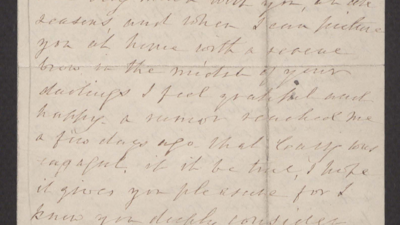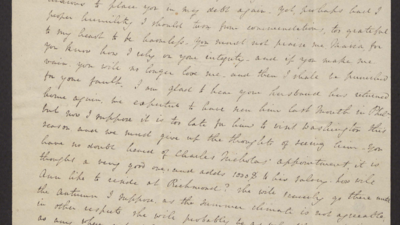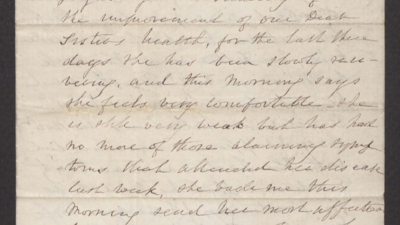Oral History Interview with Daniel Goldsmith
Title
Date
Contributor
Summary
Daniel Goldsmith was born in Antwerp, Belgium on December 11, 1931 to Polish parents. His family was orthodox and he was educated at a Yeshiva. They lived in Antwerp under German occupation and suffered under the ever-increasing anti-Jewish measures. His father was transported to a labor camp in France, August 1942 and never heard from again.
His mother, Ruchel Goldschmidt – who was in contact with the Belgian underground – managed to get some money, safeguard their possessions, and find a hiding place just before and while the Germans raided their neighborhood and ransacked Jewish-owned houses, helped by Belgians who pointed out Jewish residents. Daniel cites several instances when Belgians cooperated with the Germans. He also gives many examples of aid by non-Jewish Belgians, especially Father André (who was recognized as a “Righteous Gentile”) and other Catholic clergy and nuns. He also mentions his mother’s work with the underground.
Daniel and his sister were placed in a convent in December 1942, then with Christian families after their mother found out the Germans were going to enter the convent to look for Jewish children. He was in a succession of orphanages in Weelde and Mechelen, run by Father Cornelissen, from 1943 to 1944, while his sister lived with another Christian family. Daniel got false baptismal papers, changed his name, lived as a Catholic, but refused to convert.
In May 1944 the Germans imprisoned all circumcised boys in the orphanage, then transported them on cattle cars with other Jewish children. Daniel and several other boys escaped from the moving train and managed to contact a priest who placed each of them with a different Christian family who hid them. Monsieur and Madame Botier, hid Daniel, were kind to him, and worked to reunite him with his mother after liberation in September 1944.
Daniel describes various placements post liberation, especially in AischeEnRefail; mentions a French committee that collected hidden Jewish children, and Aliyah Bet. His mother was injured during an air raid and could not take care of her children at that time. He relates how difficult and painful it was for all parties, especially his sister, when his mother wanted to reclaim her daughter from the Christian family that sheltered her for three years.
In April 1948, Daniel, his mother and his sister went to the United States from Belgium, sponsored by his father’s family. He talks about his family’s life shortly after they arrived, and his own life from that time to the present.
More Sources Like This
of
Adam Tems
Adam Tems was born in Lódz, Poland on July 18, 1911. He describes his upbringing and education before World War II. He discusses how antisemitism affected the lives of Polish Jews. He details the rule numerus clausus which was used in Europe to restrict Jewish students from study. He managed to get dual degrees in mechanical and electrical engineering even though the University of Warsaw would not admit him because he was Jewish. He was inducted into the Polish Army, felt he was held back from leadership roles because of his religion and after refusing to sing anti-Jewish songs with his troop was punished by being sent to court and jail on 16 different occasions after having been threatened with death for not following orders. The Germans took him prisoner September 3, 1939. He escaped. In Lódz he was arrested by the GESTAPO and interned in a camp at Radogost (Radogoszcz).
After his release, he was reunited with his family in the Lódz Ghetto. He describes life in the ghetto, which was established in 1940, including food supplies, how the ghetto was organized, schools for the children. His only contact with the outside was listening to the BBC on the radio. He mentions an attempt by the Polish Socialist Party to start a resistance movement. Mr. Tems explains in great detail why Rumkowski, the head of the ghetto, was not an evil man. Mr. Tems was very involved in the administration of the ghetto and describes his many activities. He managed to protect many of the children until the ghetto was liquidated and the children were sent to Auschwitz.
Mr. Tems was deported to Auschwitz Birkenau October 27, 1944, then to Dachau, later to a subcamp of the Neuengamme concentration camp system, where he worked in a maintenance crew. He then worked in a manufacturing compound in Vechelde, south of Braunschweig and in December 1944 was sent to [possibly] Wöbbelin1, as the Germans were trying to stay away from the approaching American soldiers. His entire family perished in Auschwitz.
Mr. Tems explains how he managed to survive, details his liberation by the 9th Airborne Division, and why he decided not to go back to Lódz. He stayed in the American compound, then in a transient camp. He lived in Belgium for five years and after he finally received his papers, emigrated to the United States on October 24, 1950.
of
Gabriel Drimer
Gabriel Drimer was born May 2, 1922 in Dubova, Czechoslovakia. His family owned a bakery. He studied at the yeshiva in Bratislava and later apprenticed to learn tailoring and design. He belonged to B’nai Akiva, an Orthodox Zionist organization. He describes how anti-Jewish measures, confiscations, and deportations were instituted after the Hungarian army invaded in 1940 and relations between Jews and non-Jews changed. He relates an eyewitness account of mass murder of Jews, including his relatives, in Kamenets-Podolski in 1941. He stopped the deportation of his family due to good relations with the local police. Gabriel visited his family in the Taitch [phonetic] Ghetto in October 1943 while he was in a labor camp. His family was killed in Auschwitz except for a brother who died on the Russian front and a brother who died in the Resistance. The captain in charge of his labor camp saved all the prisoners until the Russians could liberate them.
Gabriel relates that a Ukrainian officer tried to kill Gabriel as a Jew, but a Russian officer intervened. Other Russian officers befriended the survivors. Gabriel worked with the Russian military secret police rounding up Nazis and describes their reactions. He returned to Bratislava and describes how he opened his old store, greatly expanded his business, fed survivors passing through, and met and married his wife.
In 1948, after two months of training he left for Israel with other Jews to join the Haganah. He served in the army, later was a sergeant in the police force, established a business and organized an association of 40 farms. He talks about his life and changing conditions in Israel. He emigrated to the United States in 1955 and went into business in New York.
Interviewee: DRIMER, Gabriel Date: April 21, 1985
of
Liesl Loeb
Liesl Joseph Loeb was born on June 17, 1928 in Rheydt, Rhineland, Germany. Liesl, together with her father, Josef Joseph, an attorney, and her mother, Lilly Salmon Joseph, was a passenger on the S.S. St. Louis. This German luxury Liner sailed on May 13, 1939, from Hamburg toward Havana, Cuba, with 937 Jewish refugees on board.
Liesl speaks about her family background and life leading up to Kristallnacht which she experienced, hiding in her own home while Nazi hoodlums were vandalizing it. She describes the months leading up to embarkation and conditions which had to be met before leaving Germany and immigration into Cuba, which was to be temporary until the family’s quota number was called for the United States.
She describes the trip and its complications from a child’s perspective. She speaks of her father’s sense of duty as the chairman of the passenger committee and the commitment and devotion of all its members. The desperate situation of the hapless passengers to whom no country offered a haven, especially not the United States, is emphasized. After 40 days at sea, the passengers are rescued through the efforts of the American Jewish Joint Distribution Committee (JDC), by four countries - England, Holland, France, and Belgium.
Finally the Joseph family lands in England, and their life as World War II began is described. The destiny of most of the passengers who were taken in by Holland, France and Belgium ended in tragedy when these countries were invaded by the Nazis.
She describes attending school as an “evacuee”, the internment of her father on the Isle of Man as an enemy alien and arrival in New York on September 10, 1940. She concludes with her graduation from high school, and her immediate marriage thereafter. Several footnotes pursuant to the St. Louis story are added at the end of this memoir.
Self-taped oral memoir: LOEB, Liesl Joseph Date: Nov. 17, 1998


